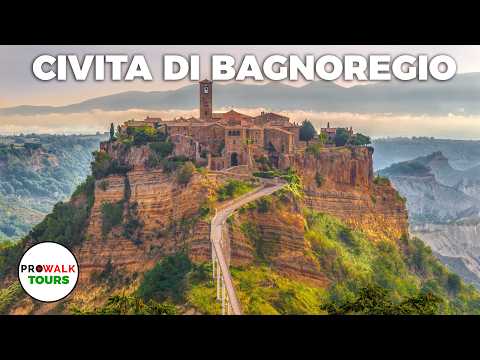Civita di Bagnoregio Walking Tour 2021

Welcome to Civita di Bagnoregio, pronounced "SHEE-vee-tah dee Bahnyo-rehj-oh." Civita di Bagnoregio lies on top of a plateau of volcanic tuff overlooking the Calanchi Valley. The Calanchi (gullies) are the Italian badlands, formed by layers of clay covered with thin layers of volcanic tuff. The clay hills have been eroded away by wind and rain forming a unique landscape of sharp ridges with colorful layers. This is the Belvedere di San Francesco Vecchio. The cave of St Bonaventure is down the steps to the right, but it is closed. The area consists of two main valleys: the Fossato del Rio Torbido and the Fossato del Rio Chiaro.
This scenic lookout marks the edge of the modern town of Bagnoregio, a small town of 3,700 located in the province of Viterbo in the Lazio region of Italy. In ancient times, the modern town of Bagnoregio was the suburb of the hill town of Civita. Bagnoregio, once known as Bagnorea, derives from Balneum Regis (King's bath) which is a reference to the presence of thermal waters in the area.
The name has been handed down at least since the Lombard era. According to a legend, in fact, King Desiderio (who died in 774 ) was cured of a serious illness, thanks to the thermal waters that flowed near the town. In 1922 a royal decree changed the name from the dialectal Bagnorea to Bagnoregio. The Etruscan people were the first to settle here over 2,500 years ago and for centuries Civita was a thriving Etruscan town. The town's position on the hill made the city easy to defend from invaders. Its location also helped to protect the locals from floods and outbreaks of malaria that affected settlements in the lower marsh lands.
While the town dates back to Etruscan times, the current architecture is medieval in origin. The ancient Etruscan name of this town is unknown. While the town of Bagnoregio continues to be a small but prosperous town, Civita has become known as La città che muore ("The Dying Town"). There was a time when Civita was a much larger town, but due to constant erosion on all sides, many parts of the town have collapsed into the valley below. Unlike much of the rest of Italy, Civita di Bagnoregio wants all the tourists it can get. They even decided to charge visitors €5 to enter the town, up until 6 pm. The parking here as well as under the bridge is for residents only. If you get an airbnb here ,ask the host for their parking pass. Worked for me! :)
This bridge was built in 1965 to replace a masonary bridge built in 1926 which was damaged during WWII. Prior to 1926, a land bridge was the only way to access this ancient town, but it too eroded away. Only residents and local workers are allowed to cross the bridge on motorcycles. While erosion is still a constant threat this dying city, the town has experienced a tourist revival in recent years. In 2010, Civita had around 40,000 visitors. By 2017, that number had increased to 850,000. In 2013, the €5 entrance fee was first put in place. As a result, communal taxes were abolished in Civita and nearby Bagnoregio.
This made Bagnoregio the only Italian town without communal taxes. The money also goes towards preserving the remaining buildings and holding back the tides of erosion. At one time, Civita had five gates, but today only one remains, the Port of Santa Maria, which can be seen up ahead.
This bridge may not look very steep, but it can be difficult for some people to walk up. Here you can see the angle of incline. It is also possible to enter the town of Civita from the badlands valley through a tunnel carved into the rock. There are numerous caves and tombs carved into the sides of the soft tuff rock around the base of Civita.
One tomb was turned into a Christian chapel in the middles ages and is known as the Cave of Saint Bonaventure. The tomb is located near the scenic lookout at the beginning of this walk, the entrance is gated off. The early Romans referred to the Etruscans as the Etrusci and it is from this root that region of Tuscany gets its name. Here you can see a wall that was built up to reinforce the buildings from further collapse.
Many famous Italian towns, such as Pisa, Bologna and Capua were actually founded by the early Etruscans. I needed to stop and catch my breath, but meant to edit out this audio. Apologies. The footbridge is approximately 315 meters long to this point.
Eventually, the Etruscans were conquered and assimilated into Rome at which point Civita became a Roman settlement. This city gate, also known as Porta Cava, was carved in the tuff during Etruscan times. On the sides of the gate are two reliefs which celebrate the victory that the inhabitants of Civita di Bagnoregio obtained in 1457 over nearby Orvieto.
Above the entrance is the municipal coat of arms. This entrance opens up into the Piazza San Pietro along Civita's main street, Via Santa Maria della Porta. This piazza, also called Piazza Colesanti, was once a thriving market place. Here you can the Colesanti Palace and the building next door, of which only the façade still remains. Directly ahead are the ruins of an old house which is now the location of the public restroom. This piazza has been the main meeting area for 2,500 years.
This is the Palazzo Comunale. The church dates back to the 7th century, when it was founded on a pre-existing Roman temple. The four columns in front are all that remain of the Roman temple. House of the Priest, with a new base that was renovated in the 1950s. The early 7th century church was enlarged in 1511 by Bishop the Bishop Ferdinand of Spain. The most famous artifact here in the church is a Pear wood Crucifix that dates back to the 1400's from the School of Donatello.
On the evening of Good Friday the Crucifix is in fact carried in procession to Bagnoregio. The Church of San Donato was the bishop’s seat until the earthquake of 1695 and then in 1699 the headquarters was moved to Bagnoregio. Here in the church are the relics of the Roman martyr, Santa Vittoria, who was stabbed to death in 251 AD. The structures you see have been built and rebuilt over the centuries so it is difficult to give an exact building date. We leave Piazza San Donato and take via Madonna della Maestà once called via della Provvidenza.
This is the longest street in Civita di Bagnoregio and goes as far as the South Gate. For centuries, Civita was ruled over by feudal lords, but in 1140 AD the settlement became a free commune. As a result, Civita experienced a period of prosperity and growth. During the 1400's, its population was decimated by a plague but this was soon followed by a strong recovery. Almost every house has a staircase to access the first floor, called "profferlo", and at each door there is a glimpse to be immortalized. In 1695, there were a series of earthquakes that marked the beginning of the end for Civita.
It was around this time that some of the population moved out into the nearby suburbs of Bagnoregio. The earthquakes destroyed much of the city with structures on the outer rim collapsing into the valley below. ...and then there are the gardens and the flowers... Next we take a tour of the Museum Antica Civitas. The museum, located on the right in via Madonna Maestà, opens when the owner wants it almost without a specific time.
The entrance is rustic with classic peasant instruments on both the right and left. This cave is a barrel cellar where the wine and oil reserves were kept. In the main cave is an ancient oil mill with an olive press. This is the base of the mill. There would have been a large mill stone that turned around the center of the base.
Here are the olive presses. The kitchen and dining room. The master bedroom. :) Here you can see the stone bridge before it was destroyed by German soldiers in 1944. This pic was taken in 1874 before the stone bridge was built in 1923.
This road leads down to the Chapel of the Madonna del Carcere and the valley below but it is currently blocked off for visitors. The Poet's Garden was once location of a monastery. Admission to the gardens is "free" with the purchase of an item form the Campomoro Farm store. Since 2006, the Campomoro Farm has operated a small store inside the gardens selling jams and olive oil.
When I visited in May, I bought some honey. This time I bought a magnet. :) I should have just walked past this orange netting. I really would have liked to have walked down to the base. This is the Chapel of the Madonna del Carcere, of the Incarcerated. The chapel was most likely an Etruscan tomb, but in Medieval times it was used as the city's jail. It did not smell to good in here.
2021-11-11 10:18


